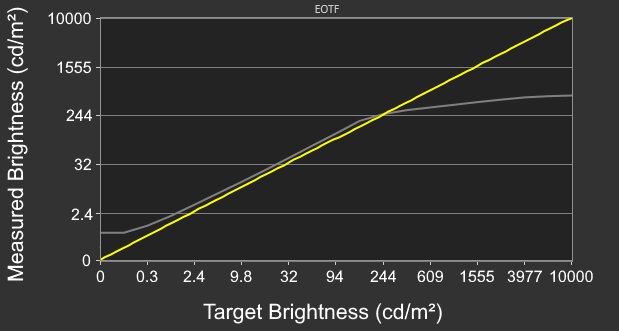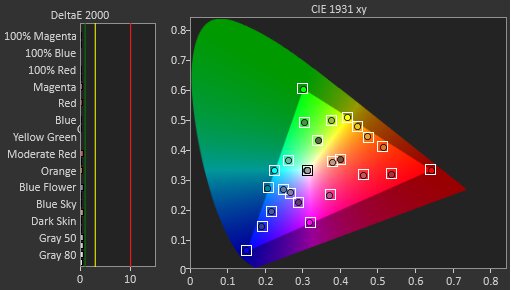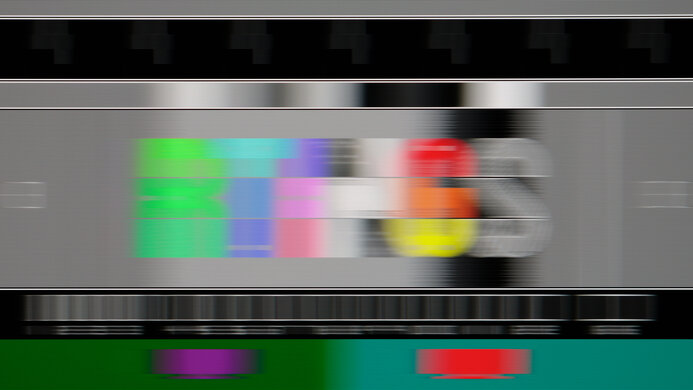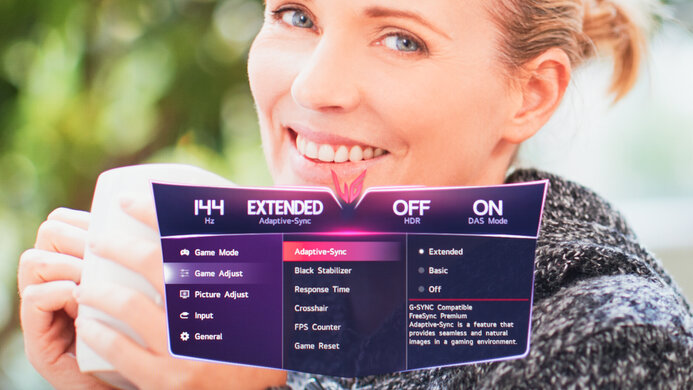The LG 27GR83Q-B is a mid-range 27-inch, 1440p gaming monitor. Part of the 2023 UltraGear gaming lineup, it's a step-down model from the LG 27GR93U-B with a lower resolution, but it has a higher 240Hz refresh rate. It has features you'd expect to find in a gaming monitor, like FreeSync VRR support and G-SYNC compatibility, and it even has HDMI 2.1 bandwidth to take full advantage of modern graphics cards. It doesn't have a ton of extra perks besides the typical gaming modes like crosshairs and a black stabilizer, but its audio port supports DTS Headphone:X audio, so you can listen to high-quality audio with compatible headphones.
Our Verdict
The LG 27GR83Q is decent for PC gaming. It has a high 240Hz refresh rate that you can achieve over DisplayPort and HDMI connections, and it supports any type of VRR format. It even has HDMI 2.1 bandwidth to take full advantage of modern graphics cards. It also has a fast response time at any refresh rate for sharp motion, and it has low input lag for a responsive feel. The one downside is that it's disappointing for dark room gaming because it has a low contrast ratio and lacks a local dimming feature to further improve the contrast.
- 240Hz refresh rate.
- Supports HDMI 2.1 bandwidth and VRR.
- Fast response time at any refresh rate.
- Low input lag.
- Low native contrast ratio.
- Still some noticeable blur.
- Highlights don't pop in HDR.
The LG 27GR83Q-B is good for console gaming. It has HDMI 2.1 bandwidth to take full advantage of the PS5 and Xbox Series X|S, but because it has a 1440p resolution, 4k images aren't as sharp as on a 4k monitor. That said, gaming feels responsive thanks to its low input lag, and it has a fast response time across its VRR range. However, it has limited picture quality, especially for HDR gaming, as blacks look gray in the dark, and it lacks a local dimming feature.
- Supports HDMI 2.1 bandwidth and VRR.
- Fast response time at any refresh rate.
- Low input lag.
- Low native contrast ratio.
- Highlights don't pop in HDR.
- Limited to 1440p resolution.
The LG UltreaGear 27GR83Q-B is good for the office. It gets bright enough to fight glare, but it struggles to handle glare from bright sources. It also has wide viewing angles that keep the image consistent from the sides, but without swivel adjustments, it's harder to share your screen with someone else. Luckily, it has good text clarity, and its 27-inch screen is big enough to open two windows side-by-side. Unfortunately, it doesn't have many extra features like a KVM switch or USB-C port, as it's limited to two USB-A ports.
- Good text and image clarity.
Bright enough to fight some glare.
- Wide viewing angles.
- No swivel adjustment.
- Lacks extra office features.
Struggles with bright glare.
The LG 27GR83Q-B is decent for media creation. It has good accuracy before calibration in its sRGB mode, but you still need to calibrate it for the most accurate colors. It also has good image and text clarity thanks to its 1440p resolution, and its 27-inch screen is big enough for multitasking, but you won't see your entire video timeline at once. It has wide viewing angles that make the image consistent from the sides, but lacks swivel adjustment to easily turn the screen to show someone else.
Bright enough to fight some glare.
- Wide viewing angles.
- Good color accuracy before calibration.
- No swivel adjustment.
- Lacks extra office features.
Struggles with bright glare.
The LG 27GR83Q-B has good brightness. It's bright enough even to fight glare from bright light sources, but small highlights don't pop in HDR.
Bright enough to fight some glare.
- Highlights don't pop in HDR.
The LG 27GR83Q has a good response time. While it maintains a consistently fast response time across its VRR range, there's still motion blur with fast-moving objects.
- Fast response time at any refresh rate.
- Still some noticeable blur.
The LG 27GR83Q-B has terrible picture quality in HDR. It has a low contrast ratio that makes blacks look gray, and it lacks a local dimming feature to further improve it. Colors don't look vivid either.
- Low native contrast ratio.
- Lacks a local dimming feature.
The LG 27GR83Q-B has okay picture quality in SDR. Its low contrast makes blacks look gray in dark rooms, but on the plus side, it displays a wide range of colors.
- Displays wide range of colors.
- Low native contrast ratio.
The LG 27GR83Q-B has great color accuracy. Its sRGB mode is accurate, but you still need to calibrate it for the best accuracy.
- Good color accuracy before calibration.
- Need calibration for best accuracy.
Performance Usages
Changelog
- Updated Nov 10, 2025: We've converted this review to Test Bench 2.1.1. We removed the Vertical Viewing Angle test.
-
Updated Jul 23, 2025:
We updated text throughout to match the new and updated tests with Test Bench 2.1, including in the Verdict section.
- Updated Jul 21, 2025: We've converted this review to Test Bench 2.1. This includes new tests for Direct Reflections, Ambient Black Level Raise, and Total Reflected Light. You can see all the changes in the changelog.
- Updated Feb 21, 2025: We've converted this review to Test Bench 2.0.1. This includes a new test result for DisplayPort 2.1 Transmission Bandwidth.
Check Price
Differences Between Sizes And Variants
We tested the 27-inch LG 27GR83Q-B, which is the only size available for this monitor.
| Model | Size | Panel Type | Resolution | Max Refresh Rate |
|---|---|---|---|---|
| 27GR83Q-B | 27" | IPS | 1440p | 240Hz |
Our unit was manufactured in June 2023 with a BOE panel; you can see the product's label here.
Popular Monitor Comparisons
The LG 27GR83Q-B is a decent mid-range gaming monitor that has more gaming features than similarly priced displays. Its HDMI 2.1 bandwidth lets you take full advantage of current-gen gaming consoles and modern graphics cards, and its 240Hz refresh rate is also ideal for competitive gaming. It also has a fast response time and low input lag, making it a well-rounded display for gaming. It isn't as versatile for other uses like productivity as some other options like the Gigabyte M27Q X, but if you're after a low-cost, high refresh rate gaming monitor, you can't go wrong with this one.
See our recommendations for the best budget gaming monitors, the best 240Hz monitors, and the best 1440p gaming monitors.
The AOC Q27G3XMN and the LG 27GR83Q-B are both 27-inch, 1440p gaming monitors. The AOC is the better choice for most gamers, as it has much deeper blacks, highlights that pop, and more vivid colors. However, the LG has much better viewing angles, so you may prefer it if you need to share your screen with someone else, though it doesn't swivel.
The Gigabyte M27Q X and the LG 27GR83Q-B are both 1440p, 240Hz gaming monitors. There are a few differences, though, as the LG supports higher HDMI 2.1 bandwidth, which is ideal for consoles or modern graphics cards, and has slightly better motion handling. On the other hand, the Gigabyte is better for content creators, as it has much better color accuracy and extra perks like a USB-C port and KVM switch.
The Dell G2724D and the LG 27GR83Q-B are both 1440p gaming monitors, with a few differences. The LG has a higher 240Hz refresh rate with a smoother feel, so this is something to consider if you play games at high frame rates. The LG also supports HDMI 2.1 bandwidth, which the Dell doesn't, so your graphics card doesn't need to use compression to reach high frame rates over HDMI. The Dell does have some advantages, though, as its stand can swivel, which the LG can't do.
The HP OMEN 27qs and the LG 27GR83Q-B are competing 240Hz, 1440p gaming monitors. They perform very similarly, and their differences come down to features. The LG has HDMI 2.1 bandwidth, letting you reach higher refresh rates over HDMI and take advantage of gaming consoles. On the other hand, the HP has a local dimming feature that helps it get brighter in HDR, but it also causes blooming, so it isn't that much of an advantage. The HP also has much better color accuracy, which is ideal for content creators.

We buy and test more than 30 monitors each year, with units that we buy completely on our own, without any cherry-picked units or samples. We put a lot into each unbiased, straight-to-the-point review, and there's a whole process from purchasing to publishing, involving multiple teams and people. We do more than just use the monitor for a week; we use specialized and custom tools to measure various aspects with objective data-based results. We also consider multiple factors before making any recommendations, including the monitor's cost, its performance against the competition, and whether or not it's easy to find.
Test Results

The build quality is good. It's mainly made of good-quality plastic, and there aren't any obvious issues. The monitor wobbles a bit on the stand, but it stabilizes quickly. The bottom bezel isn't perfectly flush with the entire screen either, but that isn't an issue unless you're really looking for it.
The ergonomics are good, but you can't swivel the screen to show it to someone next to you. You can only rotate into portrait mode in a clockwise direction, which means the inputs are always on top. The stand also has a clip for cable management.
The LG 27GR83Q has a mediocre contrast ratio, making blacks look gray in dark rooms. It doesn't have a local dimming feature to improve it. If you want a 240Hz monitor with higher contrast, then check out the Samsung Odyssey G6/G65D S32BG65D.
This monitor doesn't have a local dimming feature. Although it has a Variable Backlight setting, it only boosts the contrast level in HDR and doesn't turn off any dimming zones. We still film these videos on the monitor so that you can compare the backlight performance with a monitor that has local dimming.
The SDR brightness is impressive. It easily gets bright enough to fight glare and maintains its brightness consistently across different content. That said, its minimum brightness is a bit high, which is disappointing if you want to use it in a dark room and are sensitive to bright lights. These results are from after calibration in the 'Gamer 1' Game Mode with the Brightness at its max.
The LG 27GR83Q-B has decent HDR brightness. While it gets bright, small highlights don't pop against the rest of the image because it lacks a local dimming feature. It struggles with EOTF tracking as dark scenes are overbrightened, and it has an early roll-off, so highlights don't get the brightest they could. These results are in the 'Gamer 1' Game Mode with the Brightness at its max.
The LG 27GR83Q-B has good accuracy before calibration in the sRGB mode. It isn't perfect, though, as there are inaccuracies in the white balance and colors, and even gamma is off. Luckily, the color temperature is good, as it's only slightly on the cold side, but not enough to be noticeable. Unfortunately, the 'sRGB' Game Mode locks many settings, including Response Time, so if you want to use any of those settings, you'd have to use another picture mode that has more oversaturated colors, as you can see here.
The accuracy after calibration is fantastic. There are minimal inaccuracies, and you can use any of the settings that were locked out in the sRGB mode.
The SDR color gamut is incredible. It has perfect coverage of the common sRGB color space and good coverage of the Adobe RGB color space used in publishing. However, it oversaturates most colors in that color space, except cyans and greens, which are undersaturated.
This monitor has a great HDR color gamut. It has great coverage of the DCI-P3 color space, with good tone mapping, but most colors are slightly off. The coverage in the wider Rec. 2020 color space is more limited, as it undersaturates most colors.
The HDR color volume is decent. It's limited by its incomplete color gamut, limited HDR peak brightness, and low contrast ratio, so it can't display bright and dark colors well.
The horizontal viewing angle is good. It's a great choice if you need to share your screen with someone sitting next to you, as they'll see a consistent image from the sides.
The text clarity is good, and enabling Windows ClearType (top photo) improves the clarity. These photos are in Windows 10, and you can see them in Windows 11 with ClearType on and with ClearType off.
The direct reflection handling isn't bad. Although the matte coating spreads light out, it still has some mirror-like reflections.
This monitor does a great job at retaining its black levels the same in a bright environment. However, because of its low contrast ratio, blacks still look gray in a bright room.
To reach the monitor's max refresh rate with 10-bit signals over DisplayPort, your graphics card must support Display Stream Compression (DSC), which any NVIDIA 16 Series or AMD RX 5000 Series and newer graphics card supports. You can switch Input Compatibility Version to '1.4' if you don't want to use DSC and still get the max refresh rate with 8-bit signals.
| NVIDIA | VRR Min | VRR Max |
| DisplayPort | <20Hz | 240Hz |
| HDMI | <20Hz | 240Hz |
| AMD | VRR Min | VRR Max |
| DisplayPort | <20Hz | 240Hz |
| HDMI | <20Hz | 240Hz |
On top of supporting FreeSync VRR and G-SYNC compatibility, this monitor also supports HDMI Forum VRR.
| Refresh Rate | CAD Heatmap | RT Chart | Pursuit Photo |
| 238 | Heatmap | Chart | Photo |
| 165 | Heatmap | Chart | Photo |
| 144 | Heatmap | Chart | Photo |
| 120 | Heatmap | Chart | Photo |
| 100 | Heatmap | Chart | Photo |
| 80 | Heatmap | Chart | Photo |
| 60 | Heatmap | Chart | Photo |
The LG 27GR83Q-B has good motion handling across its VRR range. Motion looks sharp for the most part, but using the 'Fast' Response Time overdrive setting results in inverse ghosting at lower refresh rates. If that bothers you, the 'Normal' setting has more consistent motion handling across its VRR range. The 'Faster' overdrive has such a high CAD below 120Hz that it passes the limits of the chart, and you can see an alternative chart here.
The refresh rate compliance is decent. Its response time isn't fast enough to make full color transitions before the monitor draws the next frame, especially at its max refresh rate, but it's better at 60Hz.
| Overdrive Mode | CAD Heatmap | RT Chart | Pursuit Photo |
| Off | Heatmap | Chart | Photo |
| Normal | Heatmap | Chart | Photo |
| Fast | Heatmap | Chart | Photo |
| Faster | Heatmap | Chart | Photo |
The CAD at the max refresh rate of 240Hz is good. Motion looks sharp, but there's still blur and even some smearing. The 'Fast' overdrive setting has the fastest total response time, and it has a lot less inverse ghosting than 'Faster'.
| Overdrive Mode | CAD Heatmap | RT Chart | Pursuit Photo |
| Off | Heatmap | Chart | Photo |
| Normal | Heatmap | Chart | Photo |
| Fast | Heatmap | Chart | Photo |
| Faster | Heatmap | Chart | Photo |
The CAD at 120Hz is good. Although the 'Fast' overdrive setting doesn't have the fastest total response time and has some overshoot, motion still looks sharp. However, if the inverse ghosting bothers you, the 'Normal' setting is also a good choice.
| Overdrive Mode | CAD Heatmap | RT Chart | Pursuit Photo |
| Off | Heatmap | Chart | Photo |
| Normal | Heatmap | Chart | Photo |
| Fast | Heatmap | Chart | Photo |
| Faster | Heatmap | Chart | Photo |
The CAD at 60Hz is good. Unlike at higher refresh rates, the recommended overdrive setting is 'Normal' because 'Fast' and 'Faster' have too much inverse ghosting. This means you may have to change the setting if you change games or sources.
This monitor has no optional backlight strobing feature to reduce persistence blur.
This monitor has extremely low input lag for a responsive feel while gaming.
The 3.5mm audio output serves as a combo jack with audio out and mic in, but you need to have the USB-B cable connected to your computer to fully use it. It also comes with DTS Headphone:X to simulate surround sound audio.
The LG 27GR83Q-B works well with macOS. You can reach its full refresh rate with VRR and HDR on any type of connection. With a USB-C to DisplayPort cable, there's a bug with VRR where a gray bar appears on top, which causes VRR to stop working. You need to exit the full-screen mode and go back in for it to work properly again. If you're using a MacBook, windows return to their original position when you put it to sleep and wake it up again, but not when you close the lid.
This monitor has a few extra features, including:
- Black Stabilizer: Adjusts the gamma so that it's easier to see opponents in dark areas.
- Crosshair: Adds a virtual crosshair that your game's anti-cheat tool won't detect, giving you a competitive advantage.
- DFC: Changes the contrast based on the content.
- Variable Backlight: Boosts the contrast level in HDR, but it isn't a local dimming setting.
































































